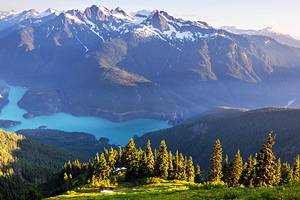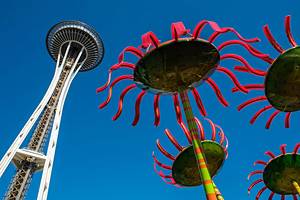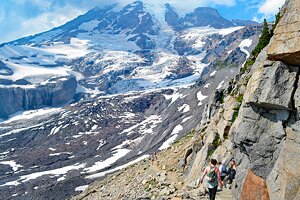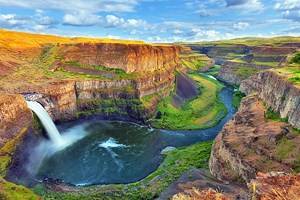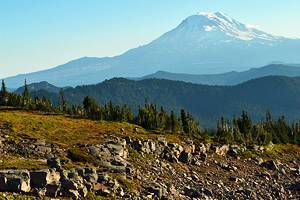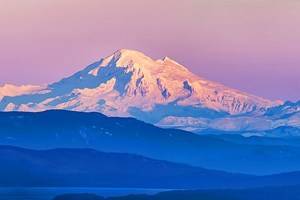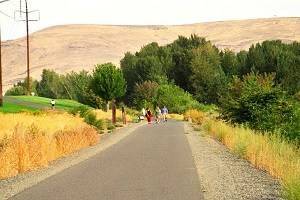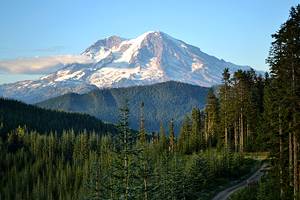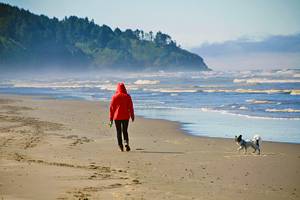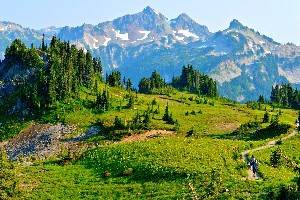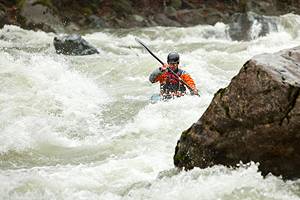Hiking Trails at Mount St. Helens
Mount St. Helens is within the Cascade Range of southern Washington, 50 miles north of Portland, Oregon. It is best known in modern history for its dramatic 1980 eruption. And today, it provides many opportunities to explore the lava-covered environment. I've explored all sides of Mount St. Helens, and while it's hard to decide on a favorite, my most memorable adventure was the steep summit hike to the blast crater.
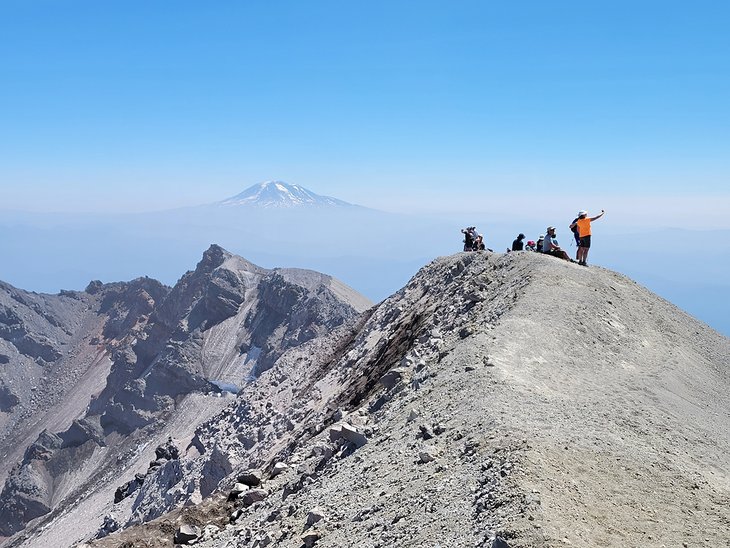
The best way to experience the dynamics of this active area is to venture out on its surrounding hiking trails, from the horseshoe-shaped crater left behind on the summit to the subterranean lava tubes formed more than 2,000 years ago. And the National Volcanic Monument overseeing the landscape maintains a variety of routes for family hikes and experienced hikers alike.
Mount St. Helens National Volcanic Monument, administered by Gifford-Pinchot National Forest, is divided into three main visiting areas: the mountain's west, east, and south sides. The west side, connected by the Spirt Lake Memorial Byway, is the easiest to access from Seattle and includes iconic places to visit, like the Johnston Ridge Observatory.
On the south side, closer to Portland, attractions like Lava Canyon and The Climber's Bivouac Trailhead are near the town of Cougar. Those looking to summit Mount St. Helens will most likely head to the Climber's Bivouac Trailhead to start their hike, also on the mountain's south side.
On the east side, accessible by the seasonal Forest Road 25, other bucket-list attractions include Norway Pass and Windy Ridge, offering front-row views of the 1980 eruption aftermath.
Explore this fascinating area with our list of the top hiking trails at Mount Saint Helens.
Boundary Trail from Johnston Ridge Observatory

Head to the Johnston Ridge Observatory on the mountain's west side for a great introduction to Mount St. Helens. Interpretive displays at the Observatory detail that massive 1980 explosion alongside a perfect view of the dismembered mountain. It's at the end of Highway 504, also known as Spirit Lake Memorial Highway, approximately 52 miles east of Castle Rock.
The Boundary Trail #1 departs in either direction from the Observatory. The trail spans over 50 miles throughout the northwest side of the park, connecting several trailheads and scenic destinations. From the Observatory, however, hikers only need to trek a few hundred feet for increasingly excellent views.
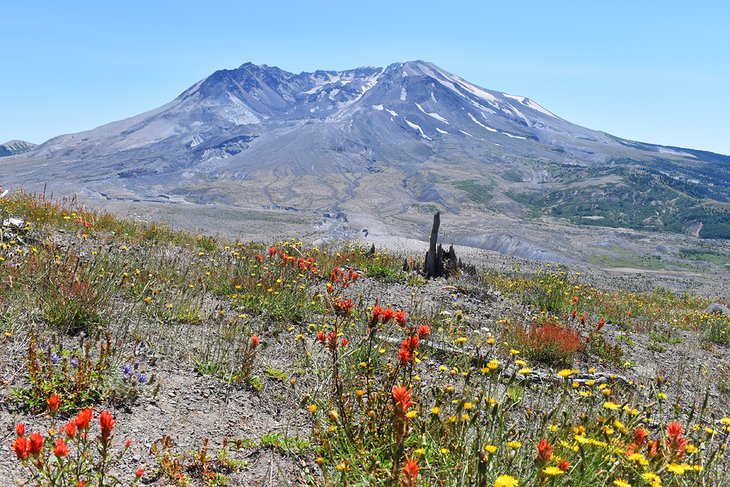
Heading east toward the mountain, the Boundary Trail extends along a rise in elevation, enabling a closer view with every step. It's a choose-your-own-adventure on how far to trek in this direction, with junctions for Truman Trail and Harry's Ridge offering viable side paths.
It pays to watch the forecast leading up to a visit and have some flexibility, if possible. Often, but not always, the afternoon sun burns off morning clouds throughout the summer. I've trekked the Boundary Trail on an overcast afternoon and on a bright, sunny day. It's still a vast landscape to explore no matter the time of year, but if you can time the sunshine right, it's a whole new experience.
The Boundary Trail also extends west from the Observatory. It connects to other prominent trails, including Loowit and Hummocks. For those looking to stretch their legs, Hummocks is a popular place to start the day with a hike up to the Johnston Ridge Observatory. Bring plenty of water, no matter the direction you're heading.
Ape Caves Lava Tube
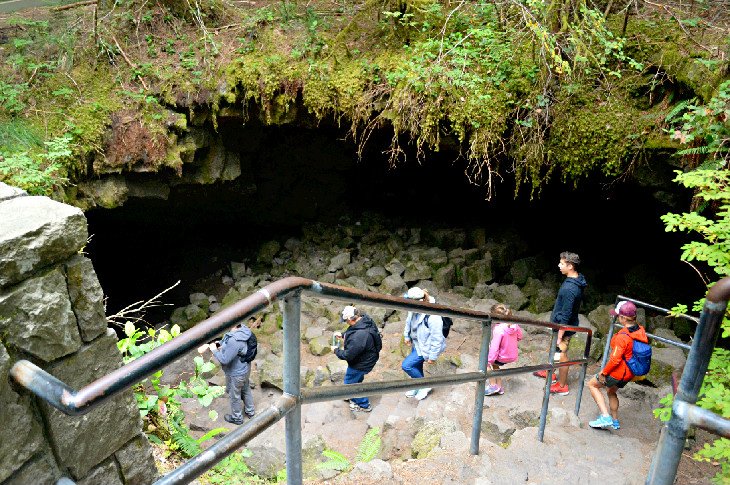
Ape Caves is the most unique hike I've done at Mount St. Helens. It's on the south side of Mount St. Helens and one of the longest lava tubes in the country, formed more than 2,000 years ago. Today, the caves allow visitors to explore the underground hallway that remains. Every visitor needs to bring a flashlight when they visit.
If you are afraid of the dark, I'd recommend skipping Ape Caves. But the lava tube is wide with relatively smooth footing and not cramped by any means. And thanks to its unique, straightforward layout, there are no wrong turns to make. These attributes allow visitors to go on a self-guided exploration and also make Ape Caves a popular family adventure.
Visitors are required to check in with the Visitor Center near the entrance of the cave. Here, park rangers informed me about the cave, ensured I had a flashlight, and screened me for White-Nose Syndrome exposure, which affects the local bat population.
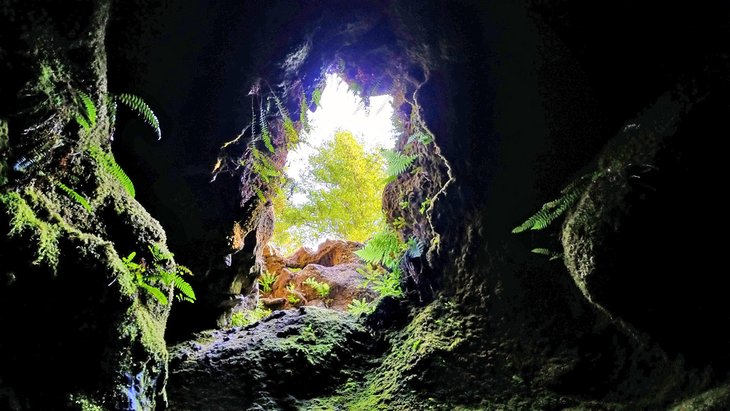
Two routes stem from the aboveground entrance, each offering a unique adventure. The Lower Trail is an out-and-back journey, traveling 1.5 underground miles, best suited for families and easy exploring.
The Upper Ape Cave Trail is a little more demanding, featuring 1.5 miles of underground rock scrambles and an eight-foot lava wall, which requires moderate climbing skills to overcome. The Upper Ape Trail exits 1.5 miles from the entrance, and visitors follow an aboveground trail to return to the visitor's center. I consider myself a seasoned explorer and had a great time doing the Upper Ape Cave Trail on my own.
Trail of Two Forests
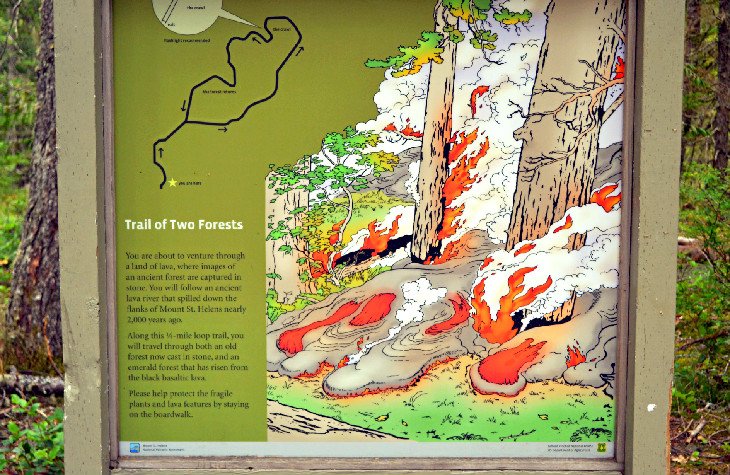
Trail of Two Forests is a family-friendly hike and a great introduction to the southern region. It provides valuable insight and interpretive information about the geological history of the mountain and its 1980 explosion.
A quarter-mile boardwalk trail navigates the area, passing through two distinct forests along the way: an old-growth forest with Douglas firs and red cedars and a relatively younger forest in an area engulfed by lava nearly 2,000 years ago.
Besides providing an interesting contrast, the lava flow left remarkable imprints of trees and root systems, better known as lava casts. I spotted several of these casts when I walked the boardwalk, only thanks to the signage pointing them out.
While patrons are encouraged to stay on the boardwalk to protect the fragile environment, one lava cast features an eight-foot ladder that allows visitors (particularly children) to crawl through a short lava mold.
Harry's Ridge Trail
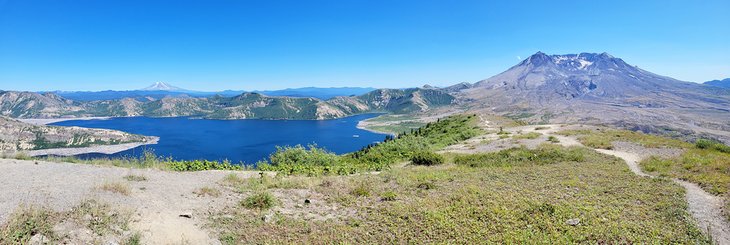
Harry's Ridge Trail is an absolute classic and exemplary hiking trail at Mt. Saint Helens. It's off the Boundary Trail and is most commonly accessed from the Johnston Ridge Observatory on the northwest side of the monument.
The round-trip distance between the Observatory and the signed Harry's Ridge Viewpoint is just over eight miles, which took me most of the day to complete, partly because I couldn't stop stopping to take pictures. From roughly mid-July to early August, wildflower blooms line the landscape, offering an interesting contrast of color against the volcano-blast surroundings.
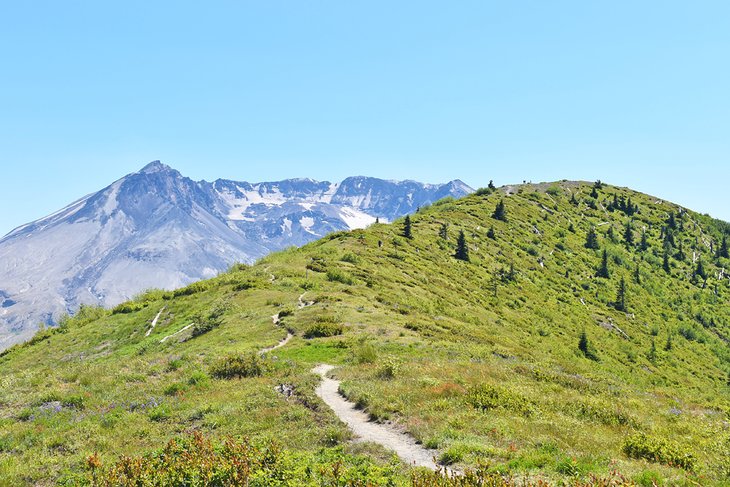
After traveling approximately 3.5 miles from the Observatory on the Boundary Trail, passing the junction for the Truman Trail, the route begins to get steep as it diverts toward Harry's Ridge. It's a steep and windy hike to the top, but on clear days, hikers enjoy panoramic views encompassing Spirit Lake, Coldwater Peak, Mount Adams, and the pumice plains, as well as blast damage from the cratered Mount St. Helens nearby.
The half-mile Eruption Trail also departs from the Johnston Ridge Observatory for an easier alternative and kid-friendly hike.
Birth of a Lake Trail
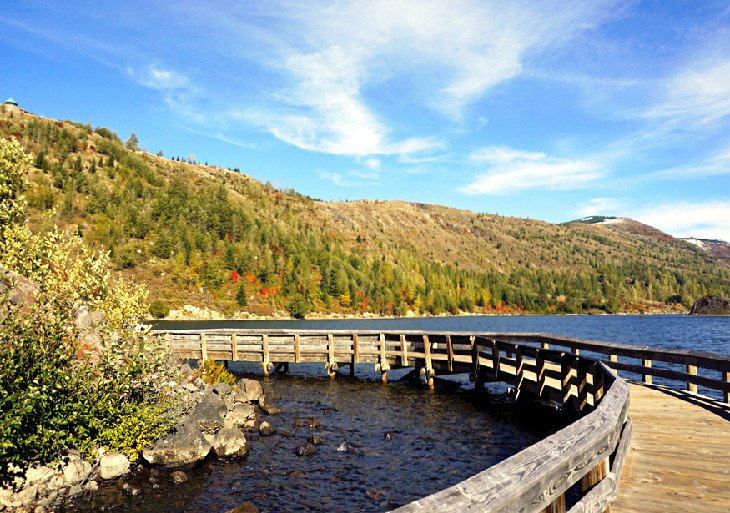
Before May 18th, 1980, Coldwater Lake was nothing but a creek. After the 1980 eruption event, the ensuing debris avalanche dammed the small waterway, creating the nearly five-mile-long body of water found today on the monument's northwest side. Two trails offer great lake views alongside interpretive information, including the half-mile Birth of a Lake Interpretive Trail.
The Birth of a Lake Trail is a kid-friendly hike following a boardwalk path adjacent to the shoreline with many interpretive signs. Expect small crowds of families during summer weekends. For further exploration, the Lake Trail departs from the nearby Coldwater Lake Boat Launch and provides a nine-mile, out-and-back route. The trek includes high views of the lake and pathways through the rebounding forest. Coldwater Lake itself is popular for non-motorized boating and fishing.
Monitor Ridge Summit Trail
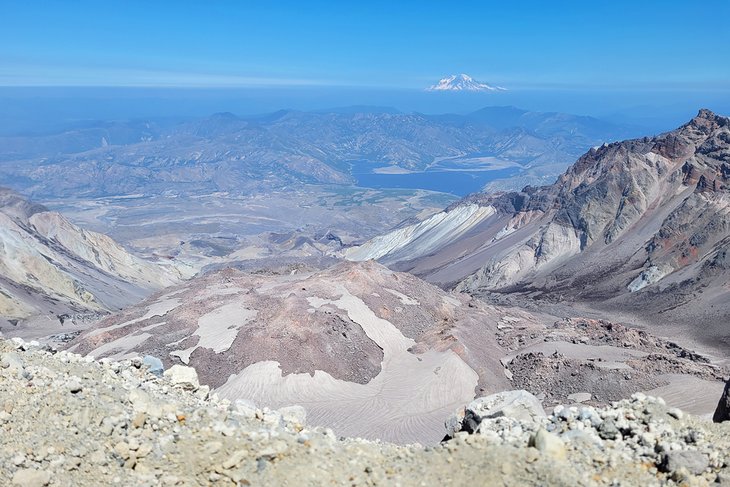
There's more than one way to summit Mount St. Helens. For warm-weather hikers, the Monitor Ridge Trail, beginning at the Climber's Bivouac Trailhead on the south side of the monument, is the preferred summer route. Permits are required to hike this renowned route to the top, as is good stamina for navigating the purely uphill terrain.
The route quickly climbs above the tree line and enters a rocky and exposed terrain within the first two miles of hiking. It's approximately a 10-mile, out-and-back round trip to reach the summit and back, and it ranks as one of the most challenging day hikes I've ever done. Technical climbing skills aren't required to reach the summit, though much of the route involves scrambling atop boulders and following wooden posts buried in the scree.
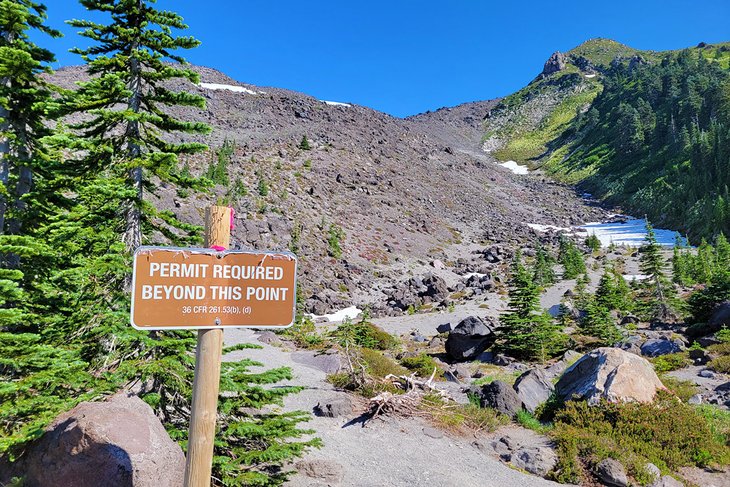
Even for experienced hikers, the route proves to be challenging. It's hard to call it hiking at some points along the trail when hands and feet are needed to scramble up rocks and boulders. And depending on the time of year, the route also navigates snowfields. For this reason, I recommend starting this hike before daybreak to ensure you have plenty of daylight, even in the height of summer.
Upon reaching the top and the edge of the horseshoe crater, an unbeatable perspective of the erupted volcano accompanies views of Mount Adams, Mount Rainier, and Mount Hood on the clearest days. The return journey down the trail is just as tricky as heading up the mountain, although typically faster, and trekking poles are recommended to save knees from the brunt of the force.
The trip took me just over eight hours, with generous time spent at the top enjoying the view and resting my legs. The Forest Service recommends allowing up to 12 hours for a trip.
Permits are required to climb above 4,800 feet on Mount St. Helens between April 1st and October 31st. Very few permits are available for walk-up status, making reservations nearly required for this bucket-list hike. The Mount St. Helens Institute maintains the most relevant information on permits and current conditions.
Hummocks Trail
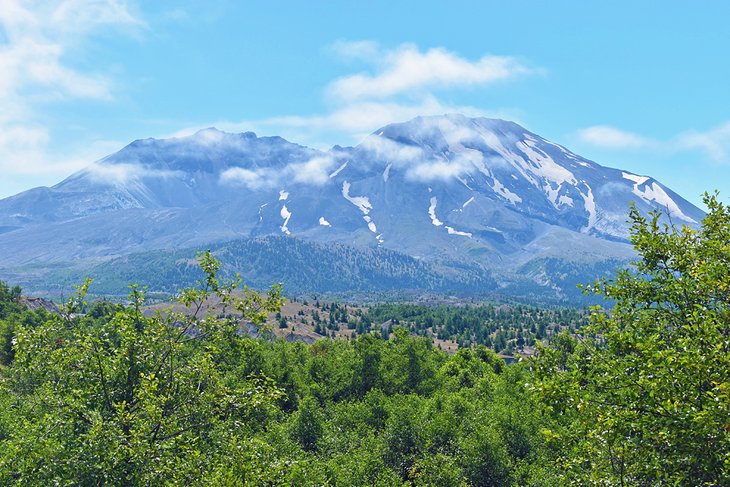
On the west side of the volcanic monument, on the way to Johnston Ridge Observatory, the Hummocks Trail is a popular family hike. It exposes a variety of Mount St. Helens landscapes, including the trail's namesake features.
Hummocks at Mount St. Helens are small knolls and earthen mounds directly resulting from the 1980 eruption. The sediment and debris that define these darkened slopes were an actual part of the mountain at one time.
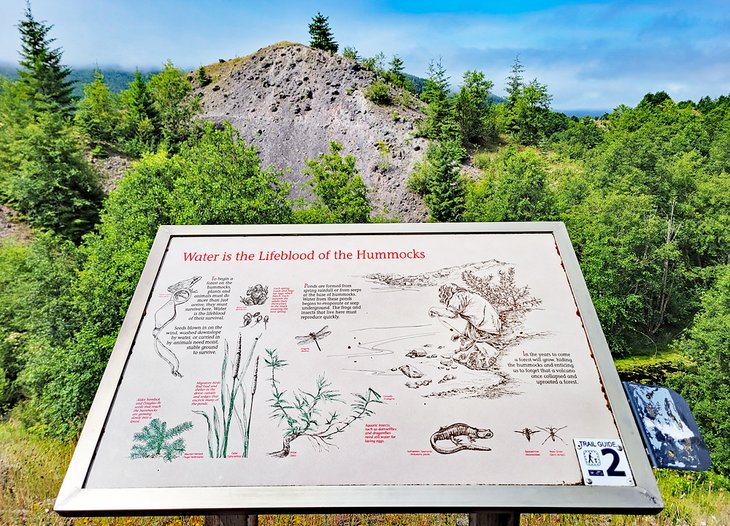
The near 2.5-mile Hummocks Trail gives the best views of these unique geological features, alongside great views of Mount St. Helens itself. It is relatively flat and filled with interpretive information that describes the events that led to their creation in greater detail.
Windy Ridge Trail
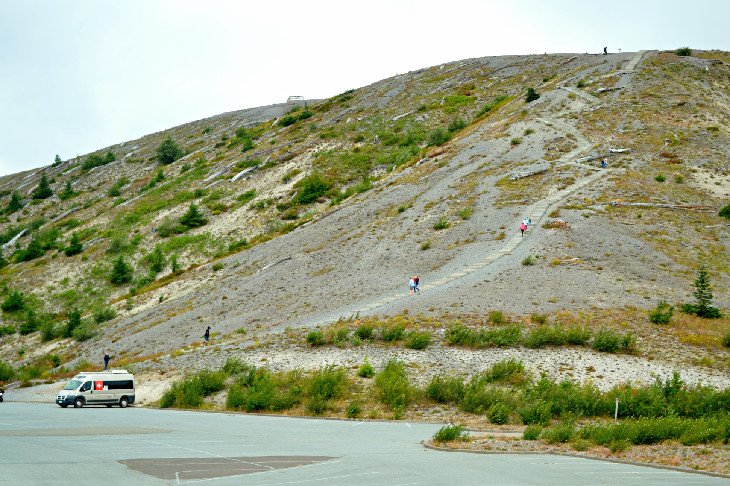
Windy Ridge is at the terminus of Forest Road 99 on the monument's northeast side, and the drive alone is half the adventure. The road is paved but has a few potholes and rough areas along the way (motorcycles use caution). Several roadside attractions also line the route, including the Miners Car Interpretive Site and noteworthy trailheads, including Norway Pass.
The drive is well worth the effort, and at the base of Windy Ridge is one of the closest views of Mount St. Helens you can access with a vehicle. From the parking area, a steep trail climbs to the Windy Ridge viewpoint, where Mt. Saint Helens and the 1980 destruction are in full view. The Truman Trail is also accessible from the Windy Ridge parking area and provides even closer views with considerably more effort.
Norway Pass

Norway Pass is on the more remote northeast side of the park, providing a great look at the different environments that now define Mount St. Helens. Climbing the 2.2-mile trail to the top of the pass is well worth the elevated effort, and on clear days, panoramic views of Mt. Saint Helens, Spirit Lake, and the massive blast zone are easily seen in the near distance.
Part of the popularity of this trail includes its gateway status for numerous other backcountry hikes, including the always-inviting Mount Margaret backcountry. If plans don't include a backcountry itinerary, it's highly recommended to drive farther south on forest road 99 after hiking Norway Pass, which ends at Windy Pass and one of the closest parking spaces next to the mountain.
Lava Canyon
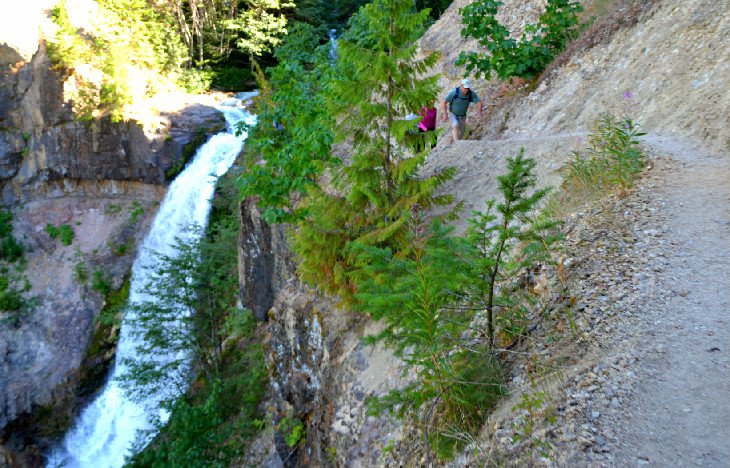
Lava Canyon highlights a timespan of geologic history at the far end of Forest Road 83 on the southeast edge of the monument. The landscape results from a volcanic mudslide scouring a canyon once filled with loose sediment. As a result, the dramatic waterfalls that now define Lava Canyon were revealed and heightened in a single event.
Visitors to Lava Canyon choose their own level of adventure with three connecting trails that increase with difficulty the farther they travel from the trailhead. A paved and easily graded path from the parking area leads to an observation point, serving as an excellent introduction to the landscape. A maintained hiking trail continues from here, eventually making a loop by crossing the water via a 125-foot cable suspension bridge.

For extra adventure, a third trail continues against the canyon wall beyond the suspension bridge, quickly descending and incorporating a 30-foot steel ladder for the steepest section. It's not a route for those uncomfortable with heights or steep edges. The footing is sound, but some areas are without handrails. Traveling with young children along this third portion of the trail is not recommended.
Harmony
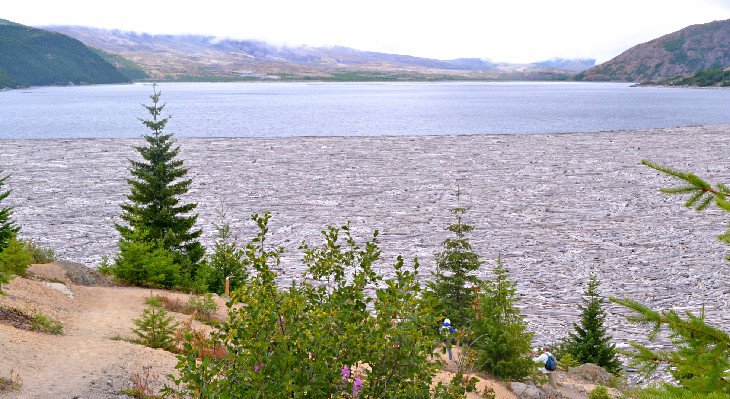
Spirit Lake is on the northeast side of Mount St. Helens. It is one of many landscapes that dramatically changed after the 1980 eruption. It was once a popular recreation area filled with campgrounds, lodges, and various hiking trails. And today, it has a somewhat eerie resonance with a quiet landscape and a few scars left behind by the blast.
The massive avalanche of debris that crashed into Spirit Lake dramatically raised its banks. The sudden splash also sent a towering tidal wave beyond the banks to collect any downed trees in its way. The resulting log mat floating in Spirit Lake is still readily visible today, offering a tangible reminder of the dramatic event.
Spirit Lake is a living scientific study of how habitat recovers after a volcanic eruption, and the only public access point to this once-popular body of water can be found on the Harmony Trail. The namesake Harmony Falls that once attracted visitors to the area is now below the waterline, and the roughly one-mile trail heading down to this altered environment is steep before hitting the shoreline.
On clear days, expect to see a great vantage point of Mount St. Helens from the water and visual remains of the eruption event. The area surrounding Spirit Lake is still recovering, and sticking to the trails is vital to any visit.
Loowit Trail
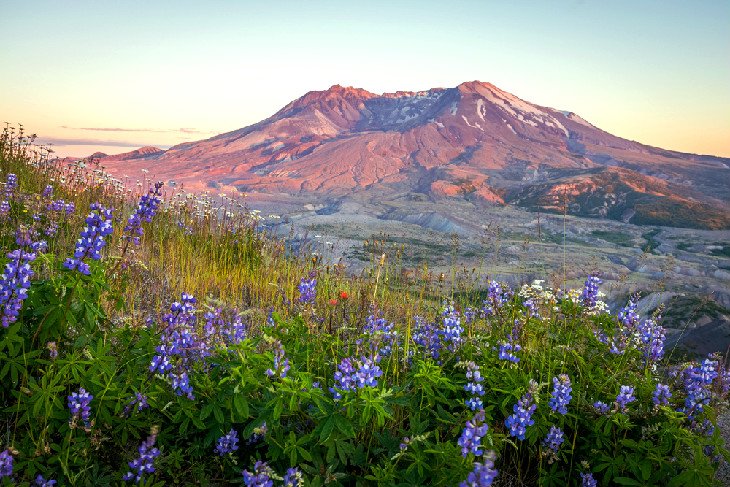
For an encompassing perspective on the 1980 eruption, the Loowit Trail circumnavigates Mount St. Helens, crossing through blast zones, mountain gullies, and a stark landscape full of unique beauty. Nearly 30 miles long, the Loowit Trail is nothing short of a challenging hike.
Besides the distance, which requires a multi-day excursion to complete (permits required for overnight travel), very few water sources and tree cover are available because the eruption stripped away much of the surrounding ecosystem.
The terrain is categorized as rough and rugged, encompassing rocky terrain and areas prone to landslides. No trailhead for the Loowit Trail can be accessed by vehicle, and interested explorers need to traverse other trails, including June Lake, to access the challenging terrain. Only experienced hikers aware of the elements should attempt cross-country travel on the Loowit Trail.
June Lake Trail
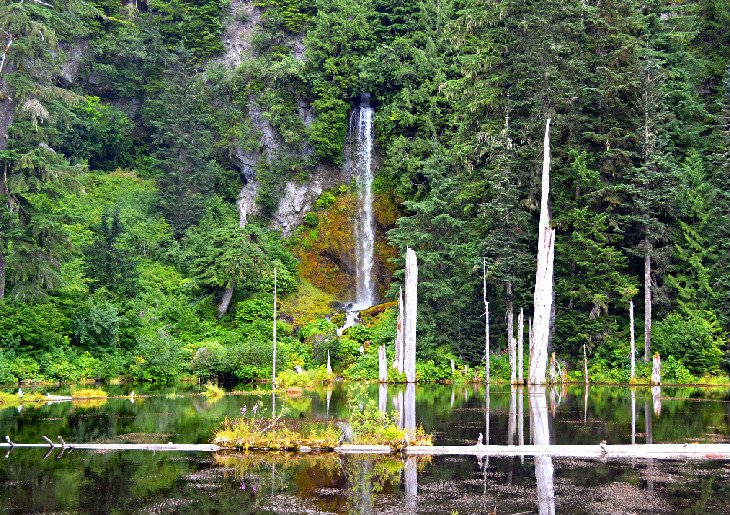
The June Lake trail is a family-friendly hike that leads to a tranquil environment with a view. From the trailhead and parking area in the southern region of the monument, the trail gently climbs for a mile before revealing a glimpse of Mount St. Helens above a large lava flow.
Continuing a quarter-mile farther, an open area of scattered trees and flat space reveals itself next to the shore of June Lake. Tucked into a small pocket against elevated terrain, the most eye-catching feature of June Lake is the cascading waterfall, which constantly refills the cold body of water. It took me a few minutes to spot this waterfall blending into the lush rock face it spills over, but as soon as I did, it was easy to appreciate from the opposite bank.
This scenic shoreline and waterfall offer an excellent turn-around point and place to have a snack before hiking back. The Loowit Trail can be accessed from June Lake by a quarter-mile (and very steep) trail connector.
More Related Articles on PlanetWare.com

Washington Parks: The best state and national parks of Washington are all something to behold, including the majestic Mount Rainier and its many hiking trails and stunning campgrounds. For any sort of adventure you can imagine, Olympic National Park provides a variety of landscapes to explore. On the north side of the state, near the Canadian border, be sure to check out the hiking trails of North Cascades National Park.

Outdoor Adventure in Washington: The state of Washington is stacked with adventures. From the best hiking trails to the top campgrounds, Washington provides waterfalls, hot springs, white water rafting, and so much more. For winter weather enthusiasts, be sure to check out our Ski Resorts in Washington State article.


